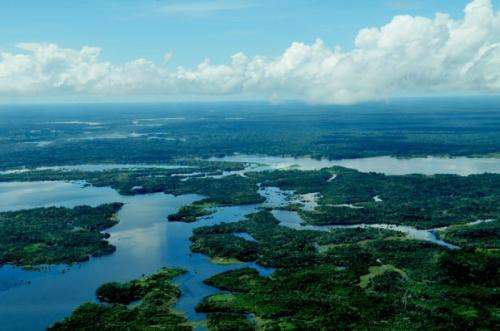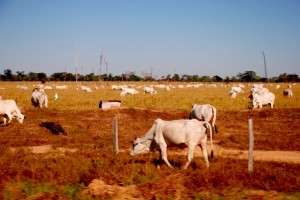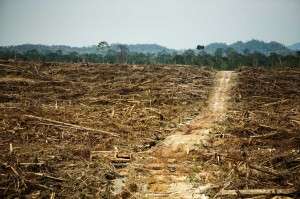Making progress on deforestation

In 2005, Brazil was losing more forest each year than any other country. The good news is that today, Brazil has reduced deforestation in the Amazon rainforest by 70 percent, according to a recent study. By not cutting down its forests and thus keeping 3.2 billion tons of carbon dioxide out of the atmosphere since 2004, Brazil has done more to reduce global warming than any other country in the world. At the same time, its soy and beef production have expanded.
A new Union of Concerned Scientists report highlights programs and policies in 17 countries across four continents that have shown progress in reducing tropical deforestation.
Forests are critical to life on Earth. They provide food, fuel, shelter, recreation and livelihoods; produce fresh water; protect the soil; regulate climate; preserve biodiversity and store carbon.
Forests are often called "Earth's lungs" because they take in carbon dioxide from the atmosphere during photosynthesis and release oxygen back out. Forested watersheds provide more than three quarters of the world's accessible fresh water. Trees absorb groundwater through their roots, and release moisture into the atmosphere, affecting the climate. Cutting down trees and clearing land reduces the amount of water in soil, groundwater and the atmosphere, which can lead to erosion, flooding, landslides and desertification.
Forests provide habitat for wildlife and plants—80 percent of the world's known biodiversity is found in tropical rainforests. It's estimated that rainforest deforestation is causing the loss of 137 plant, insect and animal species daily—an average of 50,000 species each year. Four hundred medicinal plants are at risk of extinction from over-harvesting and deforestation, which could mean the extinction of future cures for diseases; and this does not even take into consideration plants whose medicinal potential we don't yet know about.
Forests help combat global warming because they remove carbon dioxide from the atmosphere and store it—but it is only when they are growing that they can do this. The burning and decay of wood releases carbon dioxide, and deforestation can cause the release of carbon sequestered in soil. In the 1990s, deforestation was responsible for 17 percent of all carbon emissions; today that figure is down to 10 percent.
While the news about Brazil and the 17 countries is indeed good, over 224,000 square miles of Amazon forest in Brazil—an area almost the size of Texas—have been destroyed since 1980. And though figures vary according to how "forest" is defined, the Food and Agriculture Organization of the UN, (FAO), estimates that each year between 2000 and 2005, tropical forests lost 30,888 square miles (8 million hectares), while global forests lost 58,688 square miles (15.2 million hectares). Approximately half the mature tropical forests that covered the earth until 1947 are now gone.
In tropical forests, deforestation is largely driven by industrial agriculture, i.e. large-scale production of soybean, palm oil and beef; small-scale subsistence agriculture, logging and mining as well as the construction of roads to facilitate these activities are also contributors. In Southeast Asia, timber, paper and palm oil production are the main drivers of deforestation.
As more and more people move out of poverty, the global demand for meat rises.
According to the Union of Concerned Scientists, beef production, with its need for cattle pasture, uses more agricultural land than all other food sources combined. Much of the land used for this increased meat production comes from clearing tropical forests.
The growing middle class has also increased global demand for soybean and palm oils. Soybeans are used as animal feed, and the vegetable oils are used in many processed foods and products such as cosmetics and detergent. Mandates to use biodiesel in the European Union and United States also increase demand for these oils.
In Malaysia and Indonesia, palm oil plantations are the main cause of rainforest deforestation, destroying the equivalent of 300 soccer fields every hour.
Tropical logging for timber to make homes, furniture and paper products puts pressure on forests and is often done illegally. Between 1985 and 2005, the international trade of forest products more than quadrupled to $257 billion; as the global population grows, it's expected to reach $450 billion by 2020.
Subsistence farming also contributes to deforestation, though today, less so than industrial agriculture. Small farmers cut trees for fuel or to make charcoal to sell, and "slash and burn" parts of the forest to clear land for crops. In a few years, when the soil loses its fertility, they will likely move on to clear a new patch of land. After the land is abandoned, however, the forest can take up to 50 years to recover.

Understanding the extent of deforestation and the drivers behind it are essential to being able to control it.
Ruth DeFries, Denning Professor of Sustainable Development and a professor of ecology, evolution, and environmental biology at Columbia University, uses satellite imagery to track land changes and their impacts on climate and ecosystems. She explained that in the 1970s, the Landsat satellite was taking images of the Earth, but the data were very expensive and difficult to acquire. When Landsat data became publicly available in April 2008, countries were finally able to monitor their own deforestation.
"The ability to monitor deforestation in real time…and analyze it in almost real time was important for reducing deforestation, because you could see what was going on and who was doing what," said DeFries. In other words, officials could see where deforestation was occurring, and actually go into the forest to stop the illegal activity.
Global Forest Watch, a new website and map that makes near real-time information about the world's forests available to everyone, grew out of DeFries' early work at the University of Maryland. But it's still critical, she said, for countries to have their own monitoring systems and data.
DeFries monitors changes in forest cover, then uses that information to unravel the processes and causes behind deforestation to help develop effective policies. "Now deforestation is occurring more and more because of industrial scale agriculture—palm oil and soybean plantations. So that means that policies to try to control deforestation have to address these drivers," she said.
Victor Hugo Gutierrez Velez, DeFries' student and a postdoctoral research scientist at the Earth Institute, has worked in the Peruvian Amazon for the past several years. He is using satellite information and field data to assess the patterns of large-scale palm oil expansion vs. small-scale palm oil expansion, and their relative contributions to deforestation.
Gutierrez has found that over two-thirds of large-scale expansion occurred in mature forests, while 70 percent of small farm expansion happened in secondary forests (forests which have regrown after a significant disturbance by human or natural causes).
"Land that is deforested probably has an owner, so large companies would rather expand into forests because it is less likely to be owned by anyone. That means less conflict, less complication and less transaction costs for them," said Gutierrez. And yet in the Amazon region, there is ten times more deforested land suitable for palm oil production than the amount of land already being used for palm oil production. The challenge is to incentivize large plantation owners to grapple with the complexities of using deforested land.
Gutierrez described new partnerships between large companies and small producers that are forming in Colombia, Brazil and Peru. The large companies provide technical assistance, seeds and loans to small farmers who produce the palm oil and sell it to the large companies. While this appears to be a win-win-solution for the forests, the companies and the producers, there are still financial kinks that need to be worked out.
The new type of partnership for palm oil production is just one example of how each region must find the strategies that work best for it, because the drivers of deforestation can vary. The 17 successful cases across Africa, Latin America and South and Southeast Asia demonstrate that an array of strategies and new technologies are effective at reducing deforestation.
The ability to monitor in almost real time has made possible programs like REDD and REDD+. Reducing emissions from deforestation and forest degradation (REDD) and its extension, REDD+ (which includes reforestation, sustainable forestry and enhancement of forest carbon stocks) are under discussion within the UN Framework Convention on Climate Change.
When REDD was first conceived, no one knew if it would even be possible to monitor deforestation enough to implement such a program. DeFries helped develop the monitoring methods that make it possible. Through REDD+ projects, if countries reduce their rates of deforestation, they can receive payments from international programs that seek to reduce carbon emissions. The countries can then invest those payments into forest conservation programs and create economic opportunities and benefits for the local people. These benefits can be job opportunities, technical assistance, monitoring equipment, tree seedlings, improved tenure security, or investments in health or education facilities. Conservation International developed REDD+ projects that have protected 1,443 square miles (373,832 hectares) of tropical forest. Numerous countries are currently working on finalizing decisions about how REDD+ will be financed.

Efforts by nonprofit organizations and consumers to pressure corporations into being more sustainable are gaining momentum. "There are a lot of encouraging and exciting developments working with the corporate sector, because companies are concerned about their reputations and supply chains," said DeFries. More and more companies are trying to make their supply chains sustainable and buying certified products, such as certified sustainable palm oil, certified soy, or products labeled "deforestation-free."
The Union of Concerned Scientists' Palm Oil Scorecard grades the biggest American corporations on their commitments to use palm oil that is deforestation-free. Certifications provided by the Programme for the Endorsement of Forest Certification and Forest Stewardship Council ensure that timber and other forest products come from sustainably managed forests.
The right government policies on both the local and national scale are also needed to reduce deforestation. Locally, governments can encourage communities to practice low-impact agriculture or give them formal responsibility to sustainably manage their forests in exchange for social and economic benefits. Nationally, governments can promote sustainable forestry practices, support certification programs, generate markets for sustainably produced wood and create agricultural zoning that discourages agricultural development near forests. They can also establish payment for ecosystem services, where incentives are offered to landowners for managing their land to provide ecosystem services such as clean water, biodiversity conservation or sustainable forestry.
The Union of Concerned Scientists report found that REDD+ programs worked well in Guyana, Brazil, Kenya, Madagascar and Costa Rica. Payments for ecosystem services were effective in Vietnam, Mexico and Costa Rica. And more robust law enforcement made a difference in central Africa and Brazil. But in every country, when efforts to promote economic development, human rights and social progress (such as recognizing indigenous rights, offering alternative sources of income, or empowering marginalized people) were combined with efforts to reduce deforestation, the overall strategy was more likely to be successful.
So what strategies account for Brazil's extraordinary success in reducing deforestation?
Brazil's first efforts to reduce deforestation began with the establishment of protected areas in the Amazon in the late 1990s. These eventually became part of a larger plan to reduce Amazon deforestation. In 2006, Greenpeace released a report that connected the dots between the soybean industry, deforestation, global warming, water pollution and slave labor in the Amazon. Within weeks, the soy industry placed a moratorium on deforestation, and pledged not to buy any soybeans from Amazon land deforested after 2006.

Brazil's own first-rate satellite monitoring system and maps made it possible to see which farms were deforesting, enabling law enforcement to take action. In the meantime, the soy industry expanded without deforesting any land by increasing yields and practicing multiple cropping (reaping several harvests each year). Another Greenpeace report about the expansion of cattle pasture and deforestation eventually brought about a moratorium on deforestation for cattle pasture.
Today over 50 percent of the Brazilian Amazon forest is protected, and about half of this land is reserved for indigenous people, who can use it for sustainable forest management and other resources. In 2012, the forest code was updated, requiring landowners to preserve 80 percent of the Amazon's virgin forest, as well as protect watersheds.
The REDD+ program in Brazil, the biggest in the world, has already provided $670 million for reductions in deforestation. And in May 2014, the Brazilian government, World Wildlife Fund and their partners announced a $215 million fund to permanently protect 150 million acres of Amazon rainforest, an area three times the size of all U.S. national parks put together.
Tropical forests absorb almost 2 billion metric tons of carbon dioxide yearly—approximately one-fifth of the world's carbon emissions. Stopping deforestation could significantly help combat climate change as well as provide myriad environmental benefits. The recent progress proves that we now have the tools and know the strategies that work.
Source: Columbia University


















